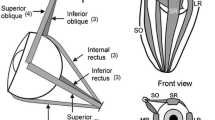Abstract
Rhesus monkeys were trained to track a moving disk using a procedure in which responses on a lever were reinforced with water delivery only when the disk, oscillating in a horizontal plane on a screen at a frequency of 0.4 Hz in a visual angle of 20°, dimmed for a brief period. Pursuit eye movements were recorded by electrooculography (EOG). IM phencyclidine, secobarbital, and diazepam injections decreased the number of reinforced lever presses in a dose-related manner. Both secobarbital and diazepam produced episodic jerky-pursuit eye movements, while phencyclidine had no consistent effects on eye movements. Lever pressing was disrupted at doses which had little effect on the quality of smooth-pursuit eye movements in some monkeys. This separation was particularly pronounced with diazepam. The similarities of the drug effects on smooth-pursuit eye movements between the present study and human studies indicate that the present method using rhesus monkeys may be useful for predicting drug effects on eye tracking and oculomotor function in humans.
Similar content being viewed by others
References
Baloh RW, Honrubia V, Sills A (1977) Eye-tracking and optokinetic nystagmus: results of quantitative testing in patients with well-defined nervous system lesions. Ann Otol Rhinol Laryngol 86:108–114
Baloh RW, Sharma S, Moskowitz H, Griffith R (1979) Effect of alcohol and marijuana on eye movements. Aviat Space Environ Med 50: 18–23
Balster RL, Chait LD (1976) The behavioral pharmacology of phencyclidine. Clin Toxicol 9:513–528
Carney JM, Uwaydah IM, Balster RL (1977) Evaluation of a suspension system for intravenous self-administration studies of water-insoluble compounds in the rhesus monkey. Pharmacol Biochem Behav 7:357–364
Drischel H (1968) The frequency response of horizontal pursuit movements of the human eye and the influence of alcohol. Prog Basic Res 22:161–174
Fuchs AF (1967) Saccadic and smooth eye movements in the monkey. J Physiol 191:609–631
Harvey SC (1980) Hypnotics and sedatives. In: Gilman AG, Goodman LS, Gilman A (eds) The pharmacological basis of therapeutics. MacMillan, New York, pp 339–375
Holzman PS, Levy DL (1977) Smooth-pursuit eye movements and functional psychoses: A review. Schizophr Bull 3:15–27
Holzman PS, Levy DL, Uhlenhuth EH, Proctor LR, Freedman DX (1975) Smooth-pursuit eye-movements and diazepam, CPZ, and secobarbital. Psychopharmacologia 44:111–115
Holzman PS, Proctor LR, Hughes DW (1973) Eye tracking in schizophrenia. Science 181:179–181
Levy DL, Lipton RB, Holzman PS (1981) Smooth-pursuit eye-movements: Effects of alcohol and chloral hydrate. J Psychiatr Res 16:1–11
Lindsey DT, Holzman PS, Haberman S, Yasillo NJ (1978) Smooth-pursuit eye-movements: A comparison of two measurement techniques for studying schizophrenia. J Abnorm Psychol 87:491–496
Lipton RB, Levin S, Holzman PS (1980) Horizontal and vertical pursuit eye movements, the oculocephalic reflex, and the functional psychoses. Psychiatr Res 3:193–203
Lipton RB, Levy DL, Holzman PS, Levin S (1983) Eye-movement dysfunctions in psychiatric patients: A review. Schizophr Bull 9:13–32
Norris H (1968) The time course of barbiturate action in man investigated by measurement of smooth tracking eye movement. Br J Pharmacol Chemother 33:117–128
Petersen RC, Stillman RC (1978) Phencyclidine: An overview. Natl Inst Drug Abuse Res Monogr Ser 21:1–17
Rashbass C (1959) Barbiturate nystagmus and the mechanism of visual fixation. Nature 183:897–898
Rashbass C, Russell G (1961) Action of a barbiturate drug (amylobarbitone sodium) on the vestibulo-ocular reflex. Brain 84:329–335
Robinson DA (1971) Models of oculomotor neural organization. In: Bach-Y-Rita P, Collins CC (eds) The control of eye movements. Academic, New York, pp 519–538
Robinson DA (1975) Oculomotor control signals. In: Lennerstrand G, Bach-Y-Rita P (eds) Basic mechanisms of ocular motility and their clinical implications. Pergamon, New York, pp 331–374
Rodin EA (1964) Impaired ocular pursuit movements. Arch Neurol 10:327–330
Rosenbaum G, Cohen BD, Luby ED, Gottlieb JS, Yellen D (1959) Comparison of Sernyl with other drugs: Simulation of schizophrenic performance with Sernyl, LSD-25, amobarbital (Amytal) sodium. I. Attention, motor function and proprioception. Arch Gen Psychiatry 1:651–656
Wilkinson IMS, Kime R, Purnell M (1974) Alcohol and human eye movement. Brain 97:785–792
Woolverton WL, Balster RL (1981) Effects of combinations of phencyclidine and pentobarbital on fixed-interval performance in rhesus monkeys. J Pharmacol Exp Ther 217:611–618
Author information
Authors and Affiliations
Rights and permissions
About this article
Cite this article
Ando, K., Johanson, C.E., Levy, D.L. et al. Effects of phencyclidine, secobarbital and diazepam on eye tracking in rhesus monkeys. Psychopharmacology 81, 295–300 (1983). https://doi.org/10.1007/BF00427566
Received:
Accepted:
Issue Date:
DOI: https://doi.org/10.1007/BF00427566




